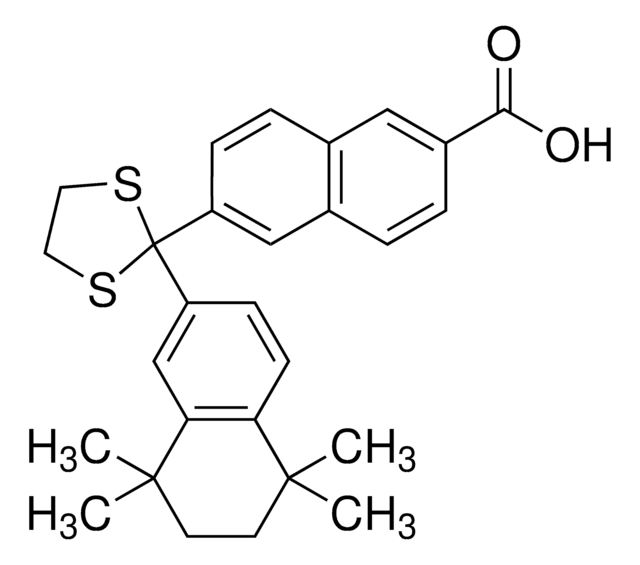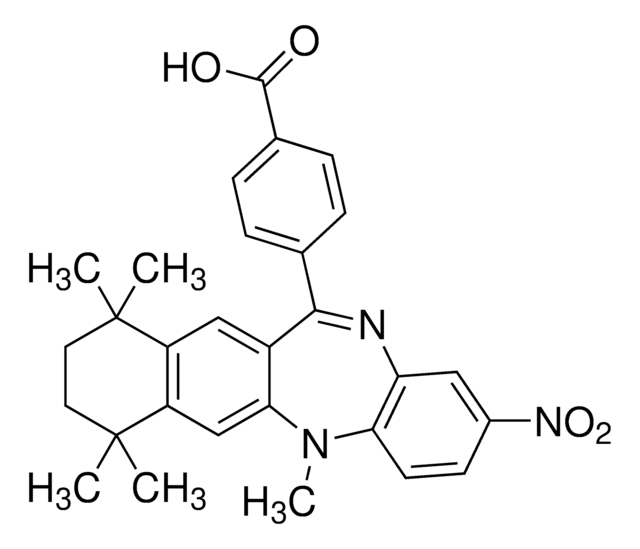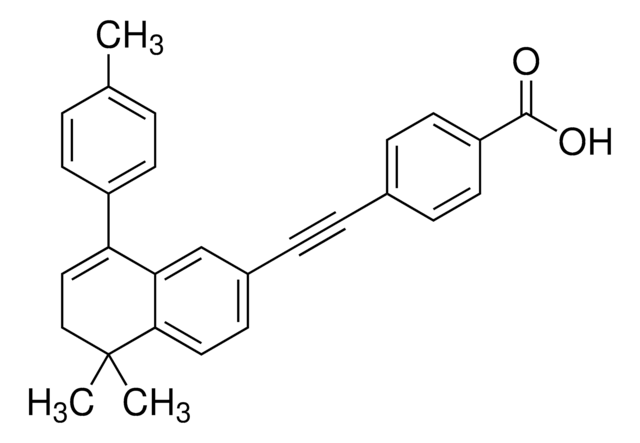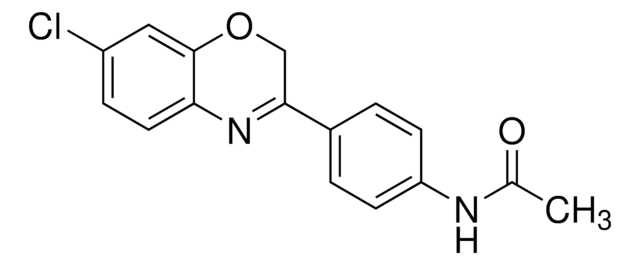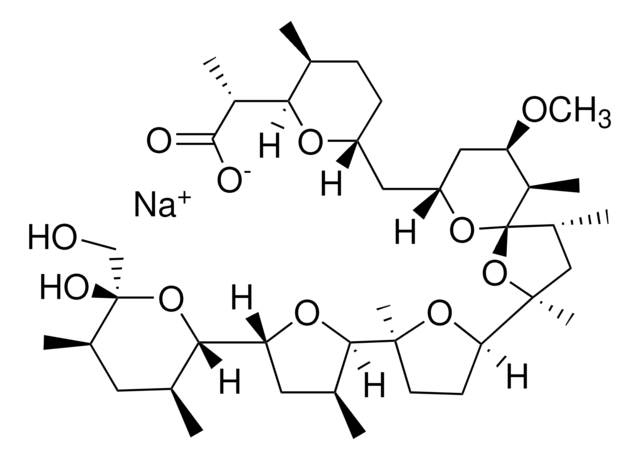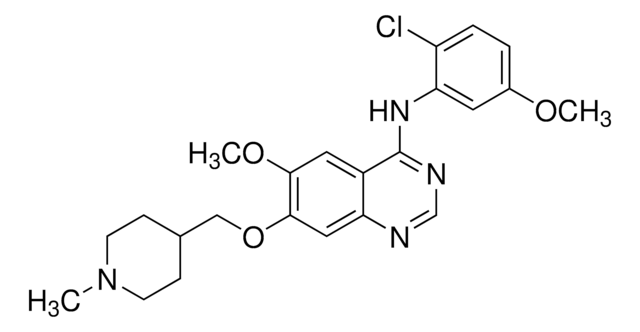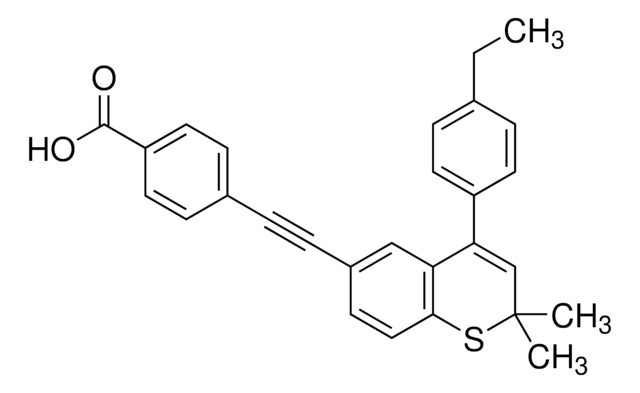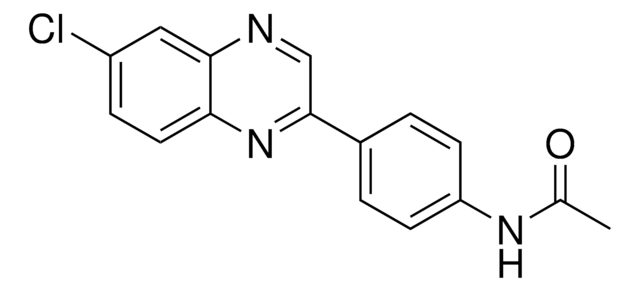おすすめの製品
品質水準
アッセイ
≥98% (HPLC)
フォーム
powder
色
white to beige
溶解性
DMSO: 20 mg/mL, clear
保管温度
2-8°C
SMILES記法
Clc1cc2c(cc1)NC(=CO2)c3ccc(cc3)C
InChI Key
PUXHKTZKBDGXBB-UHFFFAOYSA-N
アプリケーション
AR7 has been used:
- as chaperone-mediated autophagy (CMA) activator to study the activity of CMA in rat liver lysosomes
- as a CMA activator to study its effects on expression of DEAD-box helicase 3 X-linked (DDX3X), eukaryotic translation initiation factor 4A1 (EIF4A1), and eukaryotic translation initiation factor 4H (EIF4H) in cancer cells
- to study its effects on synuclein α (SNCA) oligomer levels in mature primary cortical neurons
生物化学的/生理学的作用
AR7 is an atypical retinoic acid receptor α (RARα) antagonist.
AR7 is an atypical retinoic acid receptor α (RARα) antagonist. There is high interest in retinoic acid receptors for cancer and for differentiation studies. Recently, it has been found that signaling through retinoic acid receptor α (RARα) inhibits chaperone-mediated autophagy (CMA). Disruption of RARα signaling has a stimulatory effect on CMA, but can lead to inhibition of macroautophagy. AR7 antagonizes only the CMA inhibitory effect without affecting macroautophagy, allowing the two RARα effects on autophagy to be studied independently.
シグナルワード
Warning
危険有害性情報
危険有害性の分類
Aquatic Acute 1 - Aquatic Chronic 1
保管分類コード
11 - Combustible Solids
WGK
WGK 3
引火点(°F)
Not applicable
引火点(℃)
Not applicable
適用法令
試験研究用途を考慮した関連法令を主に挙げております。化学物質以外については、一部の情報のみ提供しています。 製品を安全かつ合法的に使用することは、使用者の義務です。最新情報により修正される場合があります。WEBの反映には時間を要することがあるため、適宜SDSをご参照ください。
Jan Code
SML0921-25MG:
SML0921-VAR:
SML0921-BULK:
SML0921-5MG:
最新バージョンのいずれかを選択してください:
Y R Juste et al.
Methods in molecular biology (Clifton, N.J.), 1880, 703-727 (2019-01-06)
Chaperone-mediated autophagy (CMA) is a selective type of autophagy whereby a specific subset of intracellular proteins is targeted to the lysosome for degradation. These proteins are identified by a chaperone that targets them to lysosomes. There, they are translocated into
Yuqing Hao et al.
Autophagy, 15(9), 1558-1571 (2019-03-02)
Chaperone-mediated autophagy (CMA) is a lysosomal degradation pathway of select soluble proteins. Nearly one-third of the soluble proteins are predicted to be recognized by this pathway, yet only a minor fraction of this proteome has been identified as CMA substrates
Panagiota Mavroeidi et al.
Autophagy, 18(9), 2104-2133 (2022-01-11)
Accumulation of the neuronal protein SNCA/alpha-synuclein and of the oligodendroglial phosphoprotein TPPP/p25A within the glial cytoplasmic inclusions (GCIs) represents the key histophathological hallmark of multiple system atrophy (MSA). Even though the levels/distribution of both oligodendroglial SNCA and TPPP/p25A proteins are
Alba Navarro-Romero et al.
NPJ Parkinson's disease, 8(1), 126-126 (2022-10-07)
Mutations in the GBA gene that encodes the lysosomal enzyme β-glucocerebrosidase (GCase) are a major genetic risk factor for Parkinson's disease (PD). In this study, we generated a set of differentiated and stable human dopaminergic cell lines that express the
Philip Wing-Lok Ho et al.
Autophagy, 16(2), 347-370 (2019-04-16)
Parkinson disease (PD) is an age-related neurodegenerative disorder associated with misfolded SNCA/α-synuclein accumulation in brain. Impaired catabolism of SNCA potentiates formation of its toxic oligomers. LRRK2 (leucine-rich repeat kinase-2) mutations predispose to familial and sporadic PD. Mutant LRRK2 perturbs chaperone-mediated-autophagy
ライフサイエンス、有機合成、材料科学、クロマトグラフィー、分析など、あらゆる分野の研究に経験のあるメンバーがおります。.
製品に関するお問い合わせはこちら(テクニカルサービス)